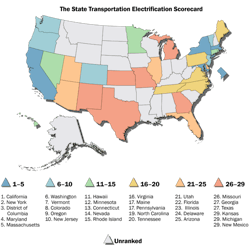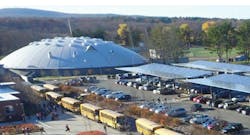The folks who set up a friendly competition among the states to spur more energy efficiency are now bringing the same strategy to electric vehicles with a new electrification scorecard.
The American Council for an Energy Efficient Economy this week released its first-ever ranking of how well states are doing in electrifying transportation. The electrification scorecard is similar to the organization’s rating of state energy efficiency achievements. With the release of its 14th edition last year, the energy efficiency scorecard has become an important credential for states that are earnest about energy efficiency.
So who are the winners and losers when it comes to electrification? Not surprisingly, California tops the list for electrification. In fact, it is far out front with a score of 91 out of the ranking’s possible 100 points. The next closest state — New York — achieved a score of only 63.5.
Courtesy of ACEEE
California’s winning hand? It is the only state to set deadlines for electrifying transit buses, heavy trucks, and commercial vehicles, said ACEEE. The organization also found California to be one of only a few states assisting lower-income drivers in replacing older cars with clean vehicles. In addition, ACEEE noted that California plans to deploy chargers in economically distressed and environmental justice communities.
“Transitioning to electric vehicles is vital for the climate and for reducing costs for households and businesses,” said Bryan Howard, state policy director at ACEEE and lead report author. “The leading states are embracing this transition, but many more are just starting, even as the automakers are preparing a burst of new electric models.”
New York, second nationally, won commendation for its strong set of incentives for individuals and fleet owners to purchase electric vehicles (EVs). The state and utilities also are incentivizing installation of charging infrastructure. And New York’s utilities have targeted more than one-quarter of the investment in their EV infrastructure program toward lower-socioeconomic and disadvantaged communities, according to ACEEE.
Others that topped the list are jurisdictions often noted for their energy innovation: Maryland, the District of Columbia, Massachusetts, Washington, Vermont, Colorado, Oregon, and New Jersey.
ACEEE sees room to grow
While many states have taken promising steps to electrify transportation, all have considerable room to improve their policies, according to ACEEE.
“Transitioning to electric vehicles is vital for the climate and for reducing costs for households and businesses,” said Bryan Howard, state policy director at ACEEE and lead report author. “The leading states are embracing this transition, but many more are just starting, even as the automakers are preparing a burst of new electric models.”
The most common electrification actions taken by states include:
- Planning for more EVs and EV charging options (23 states)
- Incentives such as rebates, tax credits, and grants to buy large electric pickups and delivery trucks (27 states)
- Use of federal funds to buy electric transit buses (48 states)
- Utility programs that offer lower electric rates at preferred times for EV (Level 2) charging (36 states)
- Utility funding to spur EV and EV charging adoption in low-income areas and environmental justice communities (15 states)
The electrification scorecard report notes that good work is being done in every region of the US.
Washington, DC received kudos for setting ambitious goals for personal EVs and strong investment in electric transit buses.
Colorado scored points for setting a goal of 940,000 EVs by 2030 and for EV incentives and utility plans for EV charging infrastructure. In addition, Colorado regulators recently approved a utility plan to install about 20,000 chargers in the state.
In Minnesota regulators issued guidelines on utility investment in charging stations, bringing $23.6 million in funding, with more proposed. The state has signaled its intent to adopt California’s zero-emissions vehicle program for personal vehicles.
And Virginia is providing solid incentives for electric trucks and buses, time-varying electric rates for home and workplace chargers, and steps to decarbonize the electric grid, according to ACEEE
For states not in the top 30, the report recommends a series of foundational steps, including leveraging existing sources of funding such as the Volkswagen settlement fund.







